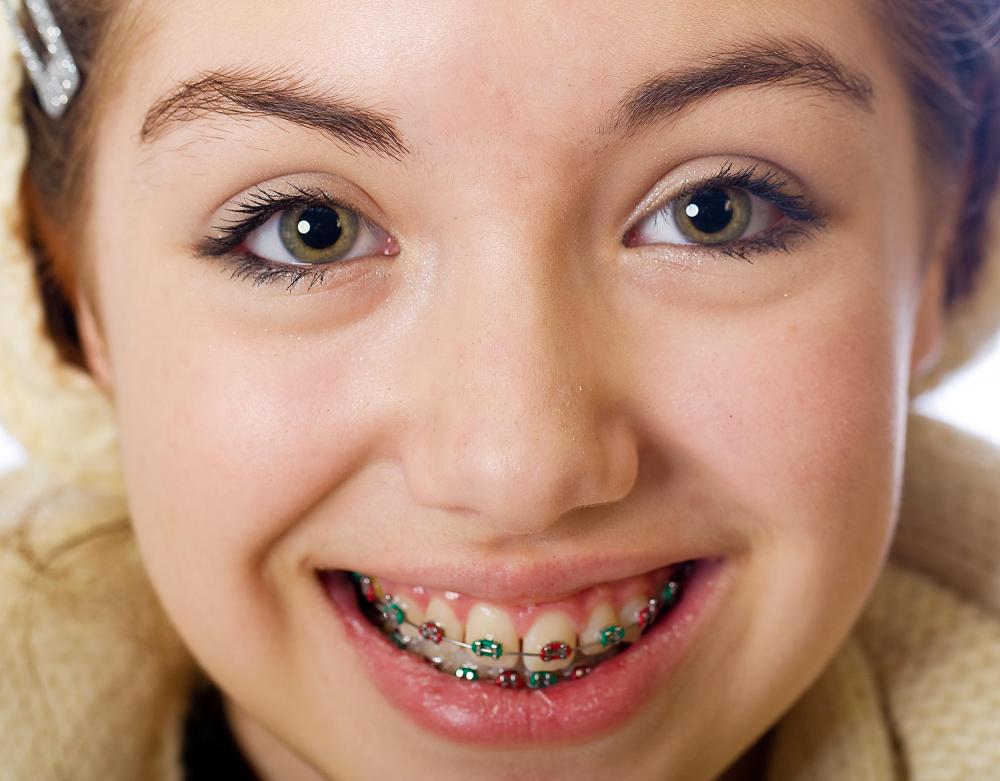At WiseGEEK, we're committed to delivering accurate, trustworthy information. Our expert-authored content is rigorously fact-checked and sourced from credible authorities. Discover how we uphold the highest standards in providing you with reliable knowledge.
What is a Fixed Appliance?
A fixed appliance is a dental appliance which cannot be removed by the patient. Dental appliances are used to move the teeth to correct malocclusions, situations in which the teeth are not aligned properly in the mouth. Depending on the nature of the malocclusion, a dental appliance may be worn primarily for cosmetic reasons, to straighten teeth which look unsightly, or it may be important for medical reasons, to correct a malocclusion which may cause difficulty eating, increase the risk of oral infections, or cause other problems.
The classic example of a fixed appliance is so-called “traintrack braces,” which consist of a set of brackets on the teeth connected with a wire known as an archwire. Traintrack braces work by putting force on the teeth to pull them into line, and may be worn for 18 months or more, with periodic adjustments made to the braces to ensure that they are pulling the teeth in the right direction. There are other types of fixed appliances which can be used as well.

Dental appliances are usually prescribed and installed by an orthodontist, a dental professional who specializes in correcting malocclusions. In addition to wearing a fixed appliance, some patients may also require surgery. For example, some patients have jaws which are out of position, in which case all the fixed appliances in the world will not address the issue, and the patient will require surgery to bring the jaw into line.

Wearing a fixed appliance can be uncomfortable. As long as the patient wears the device, special care needs to be taken to keep the teeth and mouth in good condition. Certain foods are often off limits because they can damage the appliance or leave residue which cannot be easily cleaned. After tightening and adjustments, the teeth and jaw are often sore for several days, and some patients also dislike the social attention they attract while wearing a fixed appliance. These devices are most often used in children and sometimes classmates can be cruel to children who look different, including children with obvious orthodontic appliances.

Fixed appliance therapy also requires a commitment on the part of the patient to make regular appointments and to take care of the appliance. If the appliance is left in the mouth without adjustments, it can potentially cause damage to the mouth and teeth. Likewise, if the patient neglects the appliance or does not care for the teeth properly, issues such as gingivitis and cavities can occur.
AS FEATURED ON:
AS FEATURED ON:
















Discussion Comments
Choosing to get fixed appliances for your children is an important decision. Nowadays the traditional train track braces may not be the only option, with braces like Invisalign available. There is a big difference in cost though, with the new technology being a lot more expensive and requiring more visits to the dentist for adjustments.
I think though, that if only for aesthetic reasons, that avoiding ugly train track braces would be best to keep your kids happy.
I had to wear mine later in life and I was always so self-conscious. I would have definitely preferred something invisible while my teeth were being fixed.
If you have a fixed appliance such as braces on your teeth, make sure you take care of them. Always brush them and floss as your dentist instructs. What most people don't realize is that if you don't take good care of them they can permanently stain your teeth and leave really unsightly marks.
While many braces are fairly easy to clean, if you find yours are difficult to maintain, ask your dentist about different kinds of ways you take care of them. He or she may suggest using a special cleaning pick or that you should be coming in for more cleanings in the office.
Post your comments